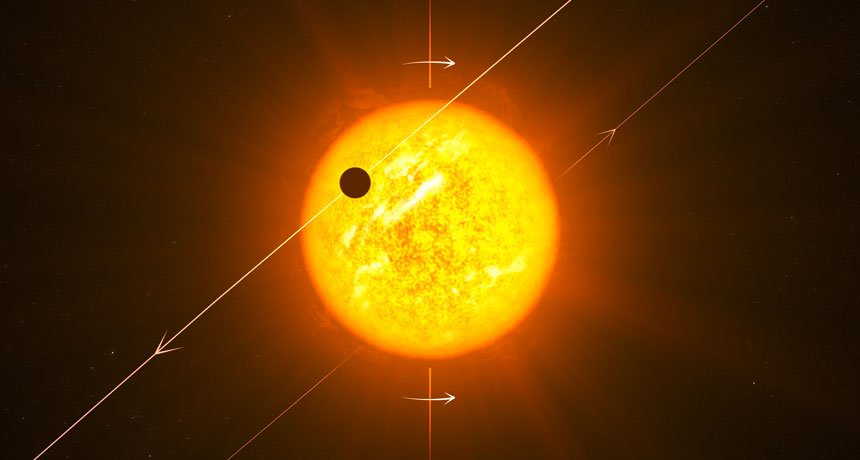
WRONG-WAY WORLDS The planet WASP-8b (illustrated here) is one of at least a dozen Jupiter-sized planets known to orbit in the opposite direction to the rotation of their host stars.
L. Calçada/ESO
They’re hot, they’re huge and they move the wrong way. In the rapidly growing catalog of planets found outside the solar system, about a dozen Jupiter-sized ones tightly circle their stars in the wrong direction. Now scientists have come up with an explanation for these wrong-way worlds that should help astronomers better understand how planets interact and might even lead to the discovery of more exoplanets.
Scientists believe they have a pretty good handle on how planets form. When a star is born, it is surrounded by a swirling cloud of gas and dust that moves in the same direction as the star’s rotation, pretty much in line with the stellar equator. Over millions of years those dust grains gradually stick together, growing larger and larger until one or more planets have cleared their own orbital paths. Since the original material was orbiting in the same direction as the star’s rotation, every planet should do so as well.
But over the last five years or so astronomers have discovered Jupiter-sized planets whose tight orbits around their stars are downright peculiar. There’s WASP-79b, which orbits its star from pole to pole. Even more puzzling are those that go backward: Their stars spin one direction, they orbit in the other. “Many theorists were originally convinced that something was wrong with the observations,” says Frederic Rasio, an astrophysicist at Northwestern University in Evanston, Ill.
Rasio and colleagues got to work explaining these wrong-way planets, with the assumption that they formed normally but somehow got thrown off their original orbits. In a new study, posted October 18 on arXiv.org, Rasio’s team fleshes out the possibility that a second planet is the cause.
His team shows through computer simulations that a giant outer planet with at least double Jupiter’s mass could exert a gravitational tug on a Jupiter-sized planet closer in and drastically skew its orbital path. First the orbit would get stretched like a rubber band, sending the inner planet on an unstable elliptical trajectory. Eventually the orbit itself would start to teeter like a slowing hula hoop, causing the planet to circle its star at an angle to the stellar equator. In some cases, the hula hoop could wobble so drastically that it would flip over the star’s rotational axis, making the planet orbit backward. “It actually happens very naturally,” Rasio says.
The catch in Rasio’s scenario is that it works only if the disruptive outer planet has a severely tilted orbit itself. In a separate study, posted October 22 on arXiv.org, another team shows how wrong-way planets could emerge even if the outer planet is in a flat orbit. It’s a similar process, though a lot more treacherous for the inner planet. For every one planet whose orbit got flipped, 49 would plunge into their stars and get incinerated. “The planet has to survive many dangerous maneuvers,” says Daniel Fabrycky, an astrophysicist at the University of Chicago who was not involved in either study.
Both papers are big steps forward, Fabrycky says, because they make detailed predictions that telescope observations could confirm. Caltech’s Cold Friends survey is one of several that are searching for companion planets of previously discovered Jupiter-sized worlds with strange orbits. As a bonus, telescopes may be able to detect the fireworks that result from unlucky planets getting swallowed by their stars, Fabrycky suggests. “You might see flashes from stars that last for days or weeks.”







